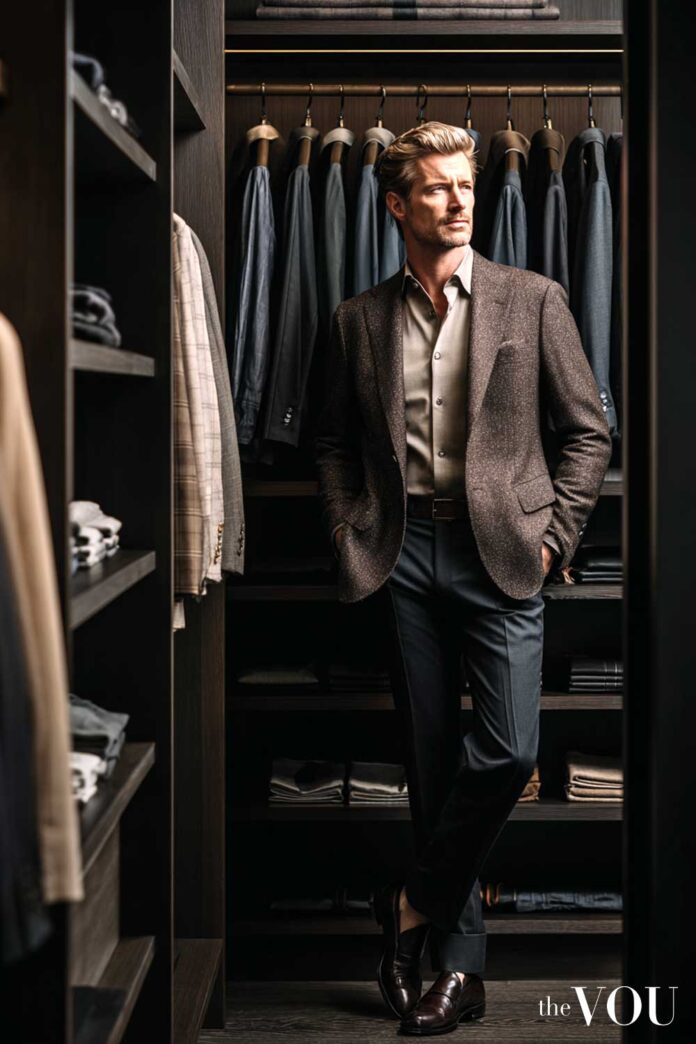The query “What is the 5 outfit rule?” points towards an ambiguous term within style discussions.
No single, universally codified principle exists under this exact name. Instead, the term likely refers to one of two distinct concepts often presented in lists of five:
- Sets of five core principles for dressing well or coordinating outfits effectively.
- A guideline suggesting new wardrobe acquisitions should offer five-way versatility.
This analysis will clarify both interpretations, providing a structured understanding of the foundational ideas commonly associated with the number five in wardrobe strategy.
1. Five Core Principles of Dressing Well
Several sources reference sets of five key rules or guidelines for achieving a polished appearance or coordinating clothing effectively.
While the specific rules may vary slightly between stylists, they converge on several core tenets essential for any man aiming to elevate his personal style. Synthesising these perspectives, we can identify five overarching principles:
1. Impeccable Fit
Proper fit forms the bedrock of a sophisticated appearance. Garments should complement your physique, neither constricting movement nor obscuring your silhouette with excess fabric.
Tailoring is often essential to achieve this precise calibration, particularly for structured items like suits and jackets. An excellent fit enhances presence and communicates attention to detail.
2. High-Quality Foundational Garments
A high-performance wardrobe relies on a core of well-made, timeless staples. Focus investment on classic garments crafted from superior materials – think quality cotton shirts, durable denim, fine wool knitwear, and Goodyear-welted shoes.
These pieces offer longevity and form a versatile foundation for numerous outfits, embodying the “fewer but better” philosophy.
3. Master Coordination (Colour, Formality, Texture)
Effective outfits demonstrate harmony between components. Learn to coordinate colours using principles of complementarity rather than exact matching for a more dynamic look.
Ensure leathers (belt, shoes, watch strap) and metals (buckle, watch case, jewellery) are congruent.
Crucially, maintain a consistent level of formality across all items; pairing a formal jacket with casual shorts, for instance, creates dissonance.
4. Ensure Versatility
Select garments that can fulfil multiple roles within your lifestyle. Foundational pieces should transition seamlessly between different settings and pair effectively with various other items in your wardrobe.
Versatility maximises the return on investment for each piece and simplifies outfit creation.
5. Maintain Appearance (Garment Care & Grooming)
Investment in quality clothing necessitates proper maintenance. Adhere to care labels, utilise appropriate hangers and shoe trees, and address repairs promptly.
Equally important is personal grooming – a sharp haircut, tidy facial hair, and attention to skin and nails complete the polished presentation that well-chosen clothes initiate.
2. The “Five-Way Versatility” Guideline
A second interpretation, sometimes referred to as the “5 outfit rule,” functions as a purchasing guideline, particularly relevant for building minimalist or capsule wardrobes.
This principle dictates that before acquiring a new item, you should be able to envisage at least five distinct outfits incorporating it, using pieces already present in your existing wardrobe.
This serves as a rigorous test of an item’s potential versatility and integration capabilities. If a prospective purchase fails this test, it may represent a poor investment – an item likely to be worn infrequently or only in a single configuration.
Adhering to this guideline encourages more thoughtful acquisitions, focusing on pieces that significantly enhance the combinatorial possibilities of your wardrobe, thereby maximising utility and value.
Conclusion – Frameworks for Elevated Style
While a singular, formally defined “5 outfit rule” remains elusive, the concepts associated with it highlight essential truths in effective wardrobe management.
Mastering a set of foundational principles – focusing on fit, quality, coordination, versatility, and maintenance – provides the bedrock for elevated style.
Furthermore, evaluating potential purchases through the lens of five-way versatility ensures a curated, high-performing wardrobe where each component justifies its inclusion.
These ideas function not as rigid constraints but as valuable frameworks for cultivating a sophisticated and impactful personal appearance.
Frequently Asked Questions (FAQs)
Q1: What are the most crucial rules for dressing well?
While lists vary, core principles consistently include: achieving a perfect fit (often through tailoring), investing in quality over quantity, understanding colour and formality coordination, prioritising versatile garments, and maintaining both your clothes and personal grooming.
Q2: How can I make my wardrobe more versatile?
Focus on acquiring high-quality staples in neutral colours (such as navy, grey, white, beige, and black) that can be easily mixed and matched. Before buying a new item, consciously plan several outfits incorporating it with pieces you already own. Consider items that can be dressed up or down, such as a navy blazer, dark-wash jeans, or minimalist leather trainers.
Q3: Should leathers and metals always match exactly?
Exact matching provides the safest and most traditional approach, particularly for formal wear (e.g., black shoes paired with a black belt). However, complementary tones can work well, especially in more casual contexts (e.g., dark brown shoes with a mid-brown belt). The key is to avoid stark contrasts (like black leather with light tan leather). Consistent metal tones (e.g., all silver or all gold/brass) create a more cohesive look, but exceptions can be made for items with sentimental value, like wedding rings.
After years of managing hundreds of fashion brands from London's office of a global retailer, Mandy has ventured into freelancing. Connected with several fashion retailers and media platforms in the US, Australia, and the UK, Mandy uses her expertise to consult for emerging fashion brands create top-notch content as an editorial strategist for several online publications.
With years of expertise in high-end fashion collabs and a PhD in Sustainable Fashion, Ru specialises in eco-luxe wardrobes for the modern gentleman seeking understated refinement.
A passionate advocate for inclusivity and diversity, Aidan is the driving force behind The VOU as its Editorial Manager. With a unique blend of editorial acumen and project management prowess, Aidan's insightful articles have graced the pages of The Verge, WWD, Forbes, and WTVOX, reflecting his deep interest in the dynamic intersection of styling with grooming for men and beyond.


